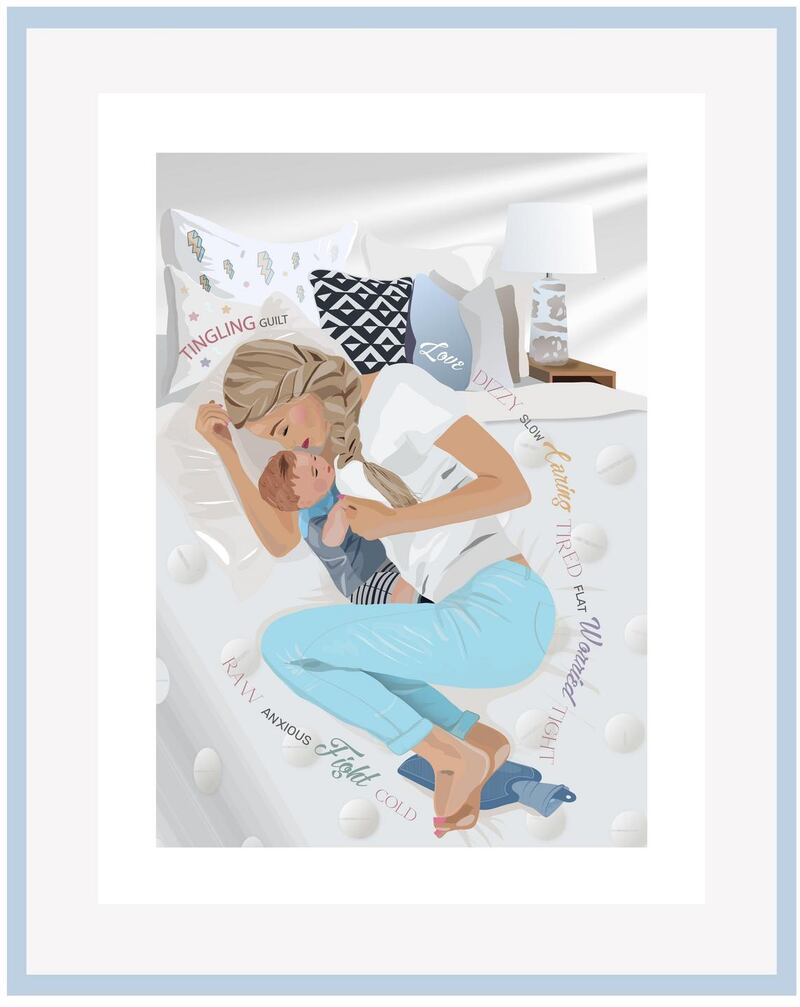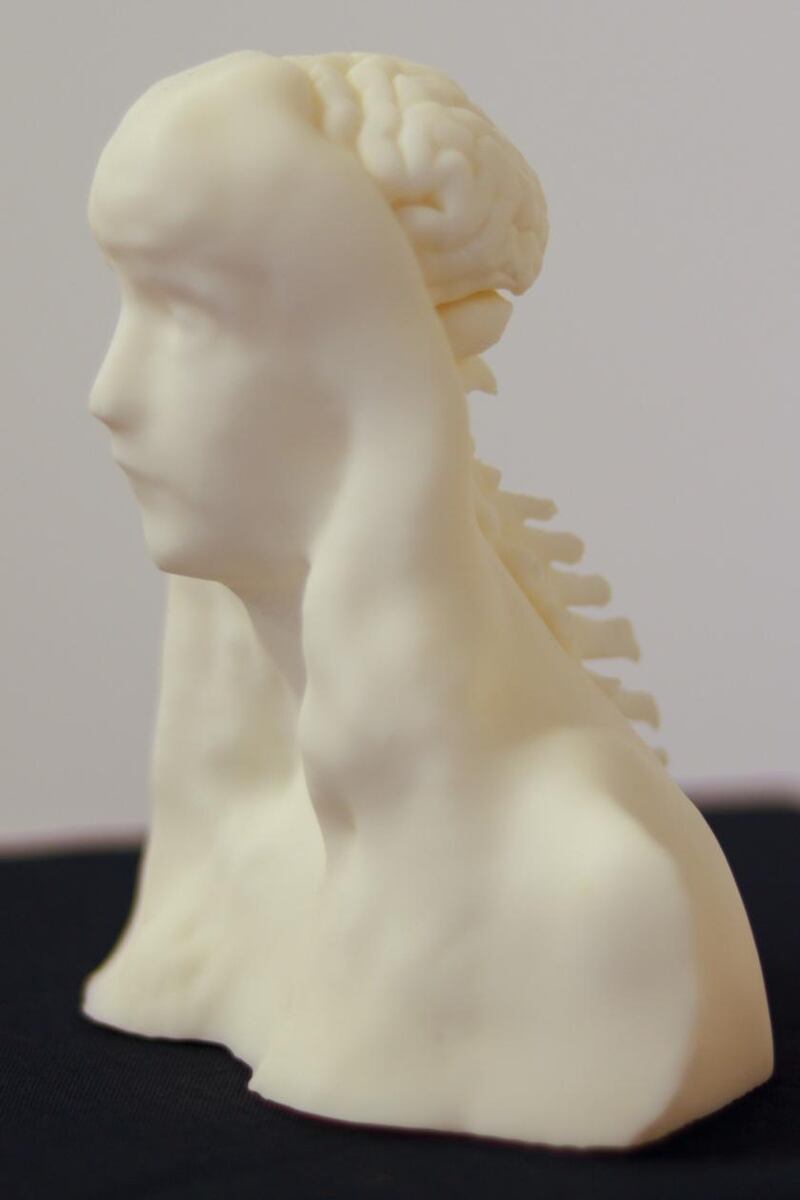Donegal-based graphic designer Marion Mulhern is one of the people living with multiple sclerosis (MS) whose work is on show in The Art of MS – Symptoms Under the Spotlight in the Trinity Biomedical Sciences Institute, Pearse Street, Dublin until June 1st.
Her piece is a digital drawing of herself and her baby son, Finn, about three months after he was born. Words including tired, flat, worried, love, guilt are scattered around the image of a mother cocooning her baby.
“I was a new mum and very protective of my baby. I wanted to be strong for him, yet there were feeling of being stressed, raw and worried about the future,” explains Mulhern, who had a relapse three months after Finn was born.
“There was so much love and happiness around our new baby, yet I was anxious and worried about my physical symptoms. I was very fatigued and dizzy and my feet felt like they were blocks of ice even though they were warm to the touch,” she explains.
Mulhern was diagnosed with MS in 2018 when she was 33. An optician spotted inflammation behind her eyes and referred her to an eye specialist who recognized it as a sign of MS. An MRI scan and lumbar puncture confirmed the diagnosis.
“I was lost when I was first diagnosed. I didn’t know anyone with MS. Many people don’t talk about it because they don’t want people to feel sorry for them or think that they aren’t able to do their work,” she explains.

Mulhern says that when she first started looking up MS online, she came across a lot of negative stuff. “A lot of blogs and online posts are a cry for help. People don’t go online when they are doing well,” says Mulhern, who decided to be open with friends and family and on social media about her condition.
“I found it empowering speaking about my MS journey. When I shared my story, so many people with MS reached out to message me and talk about how they were feeling. It’s so important not to feel alone and it’s so beneficial to speak to other people with MS,” she says.
Awareness
Celebrities with MS who speak publicly about their condition also help create more awareness of the condition. Mulhern cites actress Selma Blair – who writes about the long road to her MS diagnosis in her new memoir – as a valuable role model. "She walks with a bright, glittery cane and she has made videos about MS which are very real," says Mulhern.
Mulhern is vigilant about any potential bodily sensations and contacts the MS nurses at Sligo General Hospital if anything concerns her. “The medical team is amazing. I go there every six weeks so that they can keep an eye on the progression of MS. I have MRI scans each year. If I have a weird sensation, it can be a sign that I need rest or need to slow down a bit.”
Working as a branding specialist for the clothing company Magee 1866, she says her employers have been very supportive of her. Since her relapse at the end of 2020/start of 2021, she has been keeping well and enjoying life.
"I'm a very energetic and positive person. It's great to be fit and healthy for Finn. He is brilliant. He lights up our lives. My partner, Michael Kearney, and I got married in October 2021 and now I feel that if something happens again, we'll deal with it as a family."
Méabh Hennelly, a multimedia artist in her final year of a BA in Fine Art Media at the National College of Art and Design (NCAD) also has a piece in The Art of MS exhibition.

Diagnosed with MS at 21, she says that having the progressive neurological condition is not the biggest part of her identity. “It informs my view of myself but I’m an artist, a daughter, a girlfriend as well. I’m fit and active and my life goes on. I’m on medication to slow down the progression of the disease because I’m interested in giving myself the best shot,” she explains.
Hennelly’s artwork is a 3D printed bust of herself. “From the front, I look pretty ordinary, but the back is exposed to the brain and spinal cord to show that there is a little more going on,” adds Hennelly, who will show the piece at the NCAD graduate show from June 8th-14th following the exhibition at the Trinity Biomedical Sciences Institute. (World MS Day is Monday May 30th.)
Upsetting
She says that it can be hard when you explain to people that you have MS and they tell you upsetting things. “Why would they want to say something like that to me? There is such a range of symptoms but my prognosis is very good and I feel quite optimistic about the future. People like me can get lost in the mix of what people think MS is.”
Ava Battles, CEO of MS Ireland, says that the motivation behind The Art of MS is to show the symptoms of MS through art. "The reality of MS is so different for everyone. The symptoms [extreme fatigue, weakness in the arms and legs, sight problems, bladder and bowel dysfunction] vary from person to person and no two people will experience it in the same way," she explains.
MS is an auto-immune disease which causes damage to the myelin sheath which is the insulating layer that forms around nerves including those in the brain and spinal cord. Damage to the myelin sheath (also called demyelination) slows down, stops or distorts the electrical impulses which send messages to various parts of the body.
Battles says that the approach to MS has changed radically over the last two decades or so. “Twenty-five years ago, a neurologist would have given someone with MS a course of steroids and told them to look after themselves, but now there is a range of disease-modifying therapies, and exercise and physiotherapy have become so important.”
She says that during the pandemic, the most popular services offered by MS Ireland were the online physiotherapy sessions and exercise programmes. She hopes the exhibition will offer the public insight into the range of symptoms experienced by those with MS.
“It will show the challenges people with MS face as well as the symptoms – many of which can be invisible. You can be well one day and not the next and that’s difficult for people to understand,” she adds.











